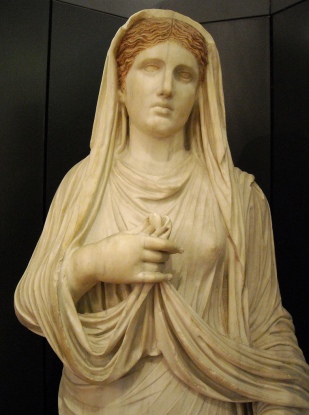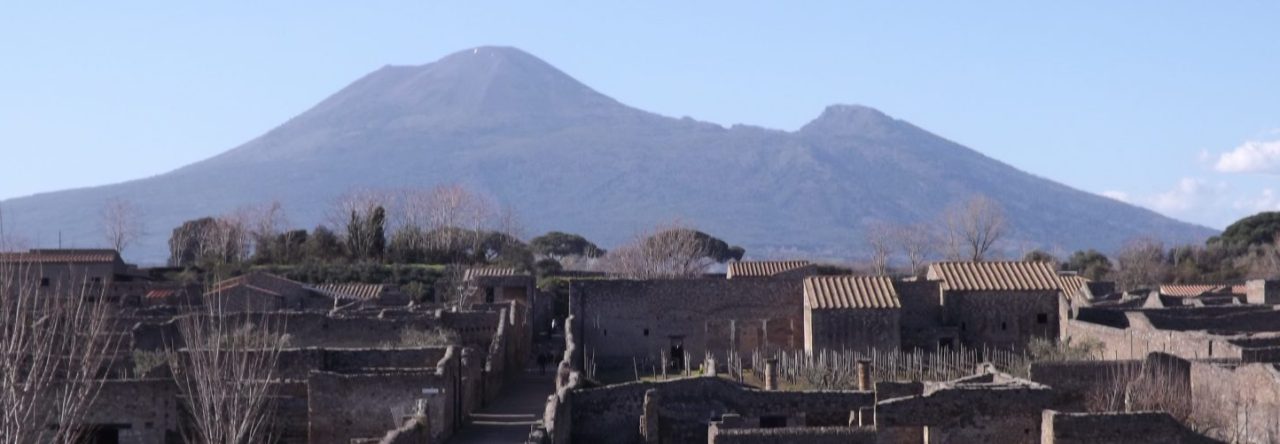
The letter E has been a bit of a dilemma for me – there aren’t many gentilicium that begin with this letter – but there are two that are considered to be families of distinction. What is somewhat remarkable about both of them – the Epidii and the Eumachii – is that they have a reputation for importance in Pompian scholarship, yet the evidence is actually somewhat scarce, but in different ways. The idiosyncratic nature of the evidence thus made me decide to derive from form and write about both.
In the case of the Eumachii, it is an issue of quality over quantity. There are only four members of the family who are actually known from thirty inscriptions. Twenty-one of these texts are found on stamps on tiles, bricks, and amphorae. Robert Étienne once suggested the family was involved with viticulture, which, if true, would naturally lead to involvement with the amphorae industry as well. These stamps potentially name two different members of the family. The majority are attributed to Lucius Eumachius (CIL X 8042.47a-b, 47d-f, 47h-i, 47k-s). Nothing further is known of this man, although he is typically thought to be the father of Eumachia. Inscriptions relating to her (see below) name her father as Lucius, and his use of two names rather than than full tria nomina suggests a Republican date, which would fit chronologically with his daughter’s rise to prominence in the Augustan period. The remaining stamps (CIL X 8042.48c-g) belong to Lucius Eumachius Erotis. The cognomen Erotis is typically associated with slaves, which makes it plausible that this man was a freedman of the family who came to operate the tile manufacturing business. He is named in one further text, a graffito found in the House of Fabius Rufus (VII.16.22). What I find remarkable about this is that if the drawing is correctly rendered, the graffito closely resembles the style of a stamp as found on a clay object:

There are six texts that name the gens Eumachia found in two locations: the eponymous Building of Eumachia (VII.9.1) in the Forum, and her tomb, in the necropolis outside the city at the Porta di Nocera. Eumachia lived during the Augustan period, was a public priestess, and built one of the largest buildings in the Forum during a period of redevelopment that also saw the erection of a temple by her fellow priestess, Mammia. The dedicatory inscription for the building repeats in two locations:
CIL X 810
Eumachia L(uci) f(ilia) sacerd(os) publ(ica) nomine suo et / M(arci) Numistri Frontonis fili(i) chalcidicum cryptam porticus Concordiae / Augustae pietati sua pe<c>unia fecit eademque dedicavit.
CIL X 811
[Eumachia] L(uci) f(ilia) sacerd(os) pub[l(ica)] // [nomine su]o et M(arci) Numistri Front[onis] // [fili(i) c]halcidicum cr[yptam] // por[ticus] // [Con]cordiae Augusta[e pietati] // [sua pec]unia fec[it] // [ea]demque dedicavit.
‘Eumachia, daughter of Lucius, public priestess, in her own name and that of her son, Marcus Numistrius Fronto, built the chalcidicum, crypt and portico at her own expensein honour of Augustan Concord and Piety and also dedicated them.’
Other inscriptions from the building include a further dedication with priestesses of Ceres (CIL X 812), and the honourific text found on the base of her statue (pictured above):
CIL X 813
Eumachiae L(uci) f(iliae) / sacerd(oti) publ(icae) / fullones.
‘Eumachia, daughter of Lucius, public priestess, the fullers (set this up).’
The tomb itself is sparse, epigraphically speaking. The primary dedication is split across two limestone tablets embedded in the façade of the tomb:
D’Ambrosio & De Caro 11OS
Eumachia / L(uci) f(ilia) // sibi et suis.
‘Eumachia, daughter of Lucius, for herself and hers.’
There are a number of columella associated with this tomb, but only one that names a member of this family.
D’Ambrosio & De Caro 11OS
L(ucius) Eumachius / Aprilis / vix(it) ann(is) XX.
‘Lucius Eumachius Aprilis, lived twenty years.’
Again, the cognomen suggests a freedman rather than a freeborn member of the family. Only one other family member is attested in the epigraphic record. Lucius Eumachius Fuscus is recorded in two texts put up by a number of Augustales, dedicated to the cult of Mercury, Maia, and Augustus (CIL X 899, 900). He is listed in the inscriptions as part of the fasti, which names the consuls in Rome and the men serving Pompeii as duoviri and aedilis in the year AD 32. He was an aedile. Castrén speculates that he is the brother of Eumachia, but it is not at all clear from the evidence. He could just as easily be the son of a freedmen, such as Lucius Eumachius Erotis, the tile maker. There is no record of the family later than AD 32.
What is interesting here, is that for all intents and purposes, the epigraphic record for the Eumachii family is relatively small. The majority of it comes from stamps on tiles and amphorae – not texts that usually garner much attention when scholars discuss the prominent families of the ancient city. The high status awarded this family is, in reality, down to the prominence of a single building. That Eumachia was able to not only fund such a large scale building project, but also able to obtain the central location it holds in the Forum, is the sole factor contributing to the reputation given to the family for their power, influence, and wealth. Her tomb, being the largest in the city, may contribute to this some as well. But what both of these projects indicate is an extreme amount of disposable wealth, not political power, nor influence of a tangible nature. It is entirely possible that the Eumachii themselves were of little significance in the social and political landscape of Pompeii. Eumachia’s euergetism may be the result of nothing more than a lucky marriage. Her husband, Marcus Numistrius Fronto, served as duovir in AD 1/2 and then died, likely leaving her incredibly wealthy. It has long been speculated that her building programme was thus intended to pave the way for their son’s entry into local politics. If she was successful in this endeavour, there is no record of it. In reviewing the epigraphic material left by her family, I can’t help but wonder if the name Eumachia would be known at all, much less be one that is so central to Pompeian studies, were it not for that one inscription that names her as the sponsor of a building.
